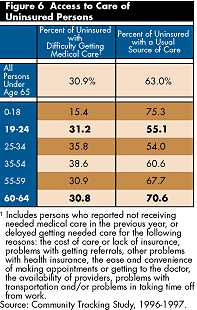Ability to Obtain Medical Care
Although the percentage of uninsured children who either did not get needed medical care or delayed getting care was much smaller than for uninsured adults -- presumably because children are in better health and need less health care -- the percentage of uninsured older adults who reported difficulty was almost identical to the percentage of uninsured younger adults who reported difficulty -- around 31 percent (see Figure 6). In fact, uninsured adults age 25 to 54 experienced the highest rate of difficulty among all uninsured persons.

Why do uninsured younger adults have about the same level of difficulty getting health care as uninsured older adults, despite being in considerably better health? One explanation is that uninsured older adults experience fewer access problems than might be expected because they are more likely to have long-established relationships with medical providers who are willing to reduce fees or provide free care. Some support for this explanation is provided by the fact that uninsured older adults are significantly more likely to have a usual source of care than are younger uninsured adults. A higher likelihood of having a usual source of care may also help explain why uninsured children have less difficulty getting care than all other uninsured persons.
A usual source of care may also enable individuals to navigate the system more effectively than those without one. Although cost barriers are the most frequently cited reason by the uninsured for experiencing access problems (mentioned by 90 percent of survey respondents who were uninsured), uninsured younger adults age 19 to 24 are more likely (26 percent) than older uninsured persons age 60 to 64 (14 percent) to also cite logistical problems in using the health care system, such as getting appointments in a timely manner, being able to get the doctor’s office during normal business hours, time spent in getting to the doctor’s office and being able to find appropriate health care providers.